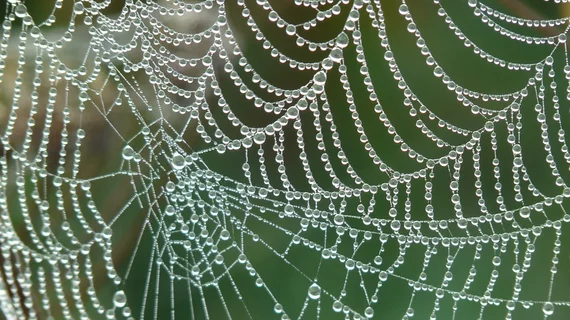Spider silk shows promise as component of robotic muscles
A recently discovered property of spider silk known as supercontraction could one day comprise a key building block of artificial muscles and robotic actuators, according to research published March 1 in Science Advances.
Spider dragline silk is a protein fiber revered for its favorable strength-to-weight ratio, flexibility and resilience, first author Dabiao Liu, an associate professor at Huazhong University of Science and Technology in Wuhan, China, and colleagues wrote in the journal. We’ve known spider silk has supercontractive properties, but until now it was unknown that those properties also triggered a twisting motion in the material.
“We found this by accident initially,” Liu said in a release. He said his team, in an effort to study the influence of humidity on spider dragline silk, suspended a weight from the silk to make a pendulum and enclosed the contraption in a humidity-controlled chamber.
“When we increased the humidity, the pendulum started to rotate,” Liu said. “It was out of our expectation. It really shocked me.”
Researchers trained in molecular modeling found the twisting motion was the result of proline—a protein building block found in MaSp2, one of spider silk’s two main proteins—folding and rotating when it was exposed to water molecules. Water disrupts proline’s hydrogen bonds in an asymmetrical way, causing it to rotate in a singular direction at a threshold of roughly 70 percent humidity.
The process of tightening, shrinking and twisting proline goes through is known as supercontraction, the authors said. Senior author Markus Buehler, a professor at MIT, called the finding “a new phenomenon.”
“This could be very interesting for the robotics community,” he said in the release. “It’s very precise in how you can control these motions by controlling the humidity. ... Maybe we can make a new polymer material that would replicate this behavior.”
The team tried using other slender, fibrous materials—like human hair—in similar experiments, but nothing else held. Buehler said the team’s findings might be applied to artificial muscles or help build more precise sensors for humidity.
“Silk’s unique propensity to undergo supercontraction and exhibit a torsional behavior in response to external triggers such as humidity can be exploited to design responsive silk-based materials that can be precisely tuned at the nanoscale,” Anna Tarakanova, another co-author, said. “Potential applications are diverse, from humidity-driven soft robots and sensors to smart textiles and green energy generators.”

